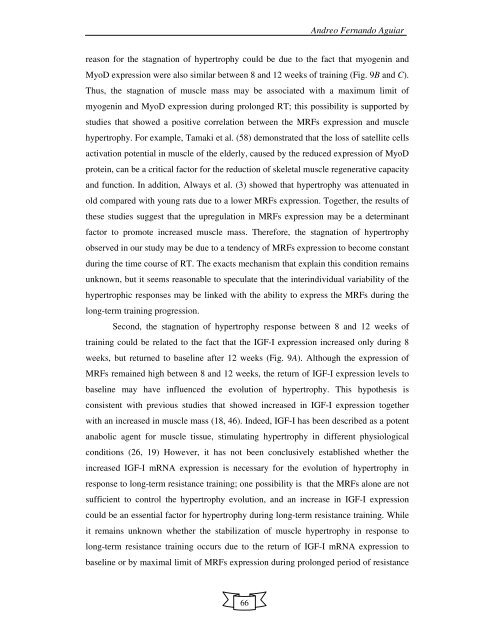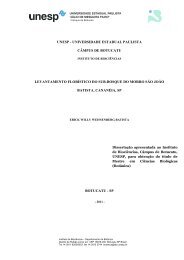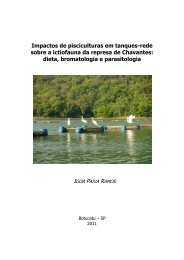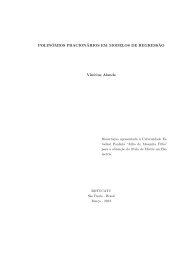Visualizar Tese - Instituto de Biociências - Unesp
Visualizar Tese - Instituto de Biociências - Unesp
Visualizar Tese - Instituto de Biociências - Unesp
You also want an ePaper? Increase the reach of your titles
YUMPU automatically turns print PDFs into web optimized ePapers that Google loves.
Andreo Fernando Aguiarreason for the stagnation of hypertrophy could be due to the fact that myogenin andMyoD expression were also similar between 8 and 12 weeks of training (Fig. 9B and C).Thus, the stagnation of muscle mass may be associated with a maximum limit ofmyogenin and MyoD expression during prolonged RT; this possibility is supported bystudies that showed a positive correlation between the MRFs expression and musclehypertrophy. For example, Tamaki et al. (58) <strong>de</strong>monstrated that the loss of satellite cellsactivation potential in muscle of the el<strong>de</strong>rly, caused by the reduced expression of MyoDprotein, can be a critical factor for the reduction of skeletal muscle regenerative capacityand function. In addition, Always et al. (3) showed that hypertrophy was attenuated inold compared with young rats due to a lower MRFs expression. Together, the results ofthese studies suggest that the upregulation in MRFs expression may be a <strong>de</strong>terminantfactor to promote increased muscle mass. Therefore, the stagnation of hypertrophyobserved in our study may be due to a ten<strong>de</strong>ncy of MRFs expression to become constantduring the time course of RT. The exacts mechanism that explain this condition remainsunknown, but it seems reasonable to speculate that the interindividual variability of thehypertrophic responses may be linked with the ability to express the MRFs during thelong-term training progression.Second, the stagnation of hypertrophy response between 8 and 12 weeks oftraining could be related to the fact that the IGF-I expression increased only during 8weeks, but returned to baseline after 12 weeks (Fig. 9A). Although the expression ofMRFs remained high between 8 and 12 weeks, the return of IGF-I expression levels tobaseline may have influenced the evolution of hypertrophy. This hypothesis isconsistent with previous studies that showed increased in IGF-I expression togetherwith an increased in muscle mass (18, 46). In<strong>de</strong>ed, IGF-I has been <strong>de</strong>scribed as a potentanabolic agent for muscle tissue, stimulating hypertrophy in different physiologicalconditions (26, 19) However, it has not been conclusively established whether theincreased IGF-I mRNA expression is necessary for the evolution of hypertrophy inresponse to long-term resistance training; one possibility is that the MRFs alone are notsufficient to control the hypertrophy evolution, and an increase in IGF-I expressioncould be an essential factor for hypertrophy during long-term resistance training. Whileit remains unknown whether the stabilization of muscle hypertrophy in response tolong-term resistance training occurs due to the return of IGF-I mRNA expression tobaseline or by maximal limit of MRFs expression during prolonged period of resistance66
















